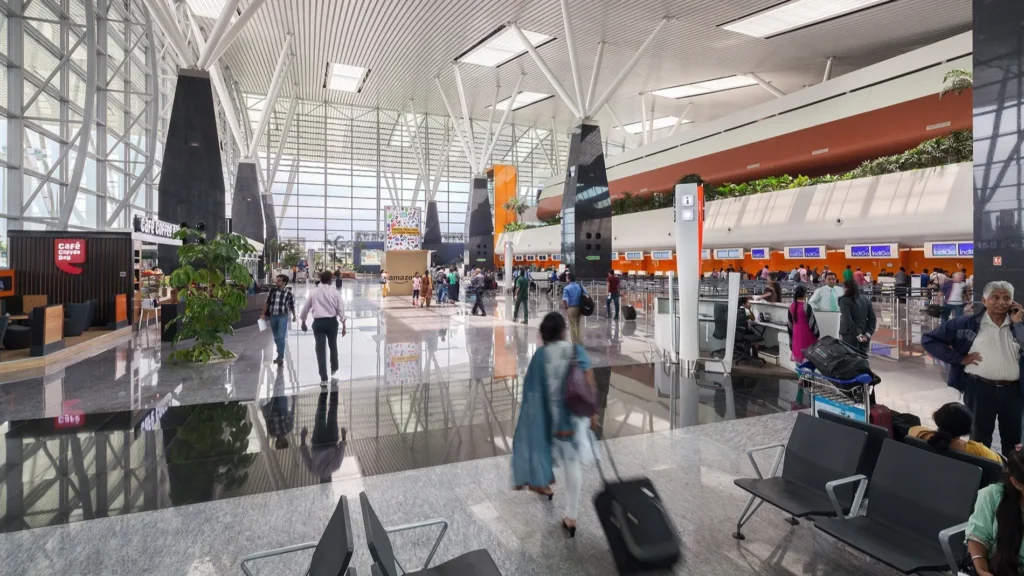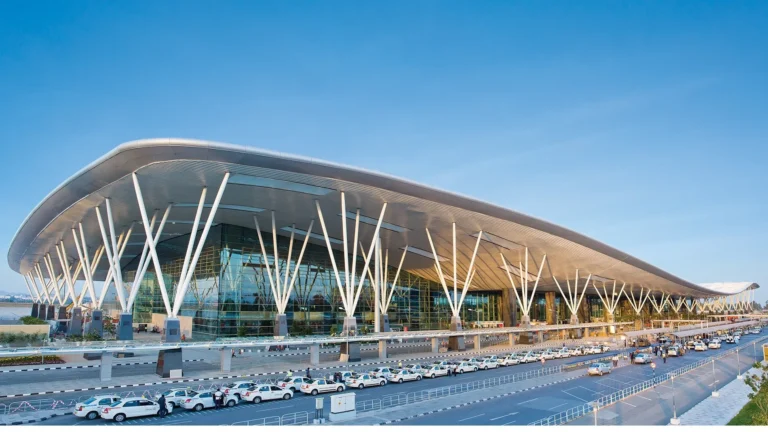BANGALORE- Kempegowda International Airport (BLR) in Bengaluru achieved a milestone by becoming Asia’s first airport to receive the Airports Council International’s (ACI) highest Level 5 accreditation.
Bangalore International Airport Limited (BIAL) reported a 95.6% reduction in Scope 1 and 2 Greenhouse Gas emissions, the highest elimination by an Indian airport. This achievement comes seven years ahead of the initial 2030 target.

Bengaluru Airport ACI Level 5 Accreditation
The accreditation takes effect from May 5, 2024, recognizing the airport’s significant progress in its decarbonization efforts.
BIAL transitioned to 100% renewable electricity and implemented sustainable mobility and green infrastructure initiatives. To offset residual emissions, the airport procured ACI-approved carbon units from verified carbon removal projects.
Looking towards 2030, BIAL commits to offsetting remaining emissions through in-house green landscape projects, reinforcing its dedication to sustainability.
Hari Marar, Managing Director and CEO of BIAL expressed pride in Bangalore Airport’s achievement as Asia’s first to receive ACI’s Level 5 accreditation. The airport reached Net Zero Greenhouse Gas Emissions seven years ahead of schedule, setting a new benchmark for Indian airports.
Further, Marar emphasized the airport’s commitment to sustainability and its role in creating a greener future. This accomplishment reinforces BIAL’s leadership in environmental stewardship within the aviation industry.
BIAL announced plans to expand its environmental efforts beyond Scope 1 and 2 emissions. Furthermore, the airport aims to achieve Net Zero GHG emissions by 2050, including Scope 3 emissions, aligning with ACI’s carbon accreditation program at Level 5.
What are these Levels?
| More advanced practices on a specific domain | 1 | 2 | 3 | 4 | 5 |
|---|---|---|---|---|---|
| Airport Community Collaboration | X | X | X | ||
| Service Design / Innovation | X | X | |||
| Airport Culture | X | ||||
| Governance | X | ||||
| Operation Improvement | X | ||||
| Measurement | |||||
| Strategy | |||||
| Customer Understanding |
ACI’s Airport Customer Experience Accreditation program consists of five progressive levels, each representing increasing sophistication in customer experience management.
Level 1 establishes a basic framework for customer experience, prioritizing it in internal and external communications. Airports at this level understand customer expectations, satisfaction, and feedback.
Level 2 introduces a clear customer experience strategy and tools, managed by a dedicated professional. A cross-functional team collaborates on the customer experience plan.
Level 3 demonstrates an advanced strategy through multifaceted engagement with customers, employees, and customer experience professionals.
Level 4 signifies a customer experience culture permeating the entire organization. Employees actively shape the customer journey, while executives recognize customer experience as a profit driver and engage stakeholders in community initiatives.
Level 5 represents the highest standard, where the corporate strategy and customer experience strategy are synonymous. Key performance indicators align with daily customer experiences, and the entire airport community unifies behind this strategy.
Also Read: Top 15 Busiest Airports in India of 2024 – Aviation A2Z

New Terminal
Bengaluru Airport initiated a major overhaul of Terminal 1 from this month, implementing measures to minimize passenger disruption during the renovation process.
Mr. Raghunath reported that Terminal 2 spans 255,000 square meters and accommodates 25 million passengers annually. However, population growth, increased demand, and new routes strain the airport’s capacity.
To address this, the airport plans to expand Terminal 2 by 200,000 square meters, increasing its annual passenger handling capacity by 20 million.
Anticipating further growth, particularly with Air India’s plans to establish Bengaluru as its southern hub and launch new international routes to North America, Europe, Far East Asia, and Australia, the airport will construct Terminal 3.

The combined capacity of all terminals aims to handle 90 to 100 million passengers annually by the early 2030s, positioning Bengaluru Airport as a major international aviation hub.
Bengaluru Airport expands its cargo operations through strategic investments and partnerships with renowned operators. The facility currently handles more international cargo than domestic, processing 266,000 metric tonnes of international and 174,000 metric tonnes of domestic consignments annually.
By 2030, the airport aims to increase its cargo handling capacity to one million metric tonnes, signaling significant growth in this sector.
To support India’s rapidly expanding domestic market, now the world’s third-largest, Bengaluru Airport is developing a new domestic cargo terminal.
Further, as per recent reports, the Karnataka government has shortlisted seven locations for a second airport to serve Bengaluru.
What are your thoughts on the Bengaluru Airport’s success story and this milestone? Let us know in the comment section below.
Join us on Telegram Group for the Latest Aviation Updates. Subsequently, follow us on Google News.

